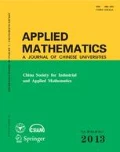Abstract
We develop a data driven method (probability model) to construct a composite shape descriptor by combining a pair of scale-based shape descriptors. The selection of a pair of scale-based shape descriptors is modeled as the computation of the union of two events, i.e., retrieving similar shapes by using a single scale-based shape descriptor. The pair of scale-based shape descriptors with the highest probability forms the composite shape descriptor. Given a shape database, the composite shape descriptors for the shapes constitute a planar point set. A VoR-Tree of the planar point set is then used as an indexing structure for efficient query operation. Experiments and comparisons show the effectiveness and efficiency of the proposed composite shape descriptor.
Similar content being viewed by others
References
A Akdogan, U Demiryurek, F Banaei-Kashani, C Shahabi. Voronoi-based geospatial query processing with mapreduce, In: IEEE Second International Conference on Cloud Computing Technology and Science, 2010, 9–16.
CB Akgül, B Sankur, Y Yemez, F Schmitt. Similarity score fusion by ranking risk minimization for 3D object retrieval, In: Proceedings of the 1st Eurographics Conference on 3D Object Retrieval, 2008, 41–48.
E Bribiesca. An easy measure of compactness for 2D and 3D shapes, Pattern Recogn, 2008, 41(2): 543–554.
M Chahooki, N Charkari. Shape retrieval based on manifold learning by fusion of dissimilarity measures, IET Image Process, 2012, 6(4): 327–336.
J Dean, S Ghemawat. MapReduce: simplified data processing on large clusters, Commun ACM, 2008, 51(1): 107–113.
V Dhar. Data science and prediction, Commun ACM, 2013, 56(12): 64–73.
L Dong, Y Wu, S Zhou. Constructing the voronoi diagram of planar point set in parallel, In: International Conference on Computational Intelligence and Software Engineering, 2009, 1–5.
Y Fang, J Xie, G Dai, M Wang, F Zhu, T Xu, E Wong. 3D deep shape descriptor, In: Proceedings of the IEEE Conference on Computer Vision and Pattern Recognition, 2015, 2319–2328.
S Fortune. A sweepline algorithm for Voronoi diagrams, In: Proceedings of the Second Annual Symposium on Computational Geometry, ACM, 1986, 313–322.
LJ Guibas, DE Knuth, M Sharir. Randomized incremental construction of Delaunay and Voronoi diagrams, Algorithmica, 1992, 7(1): 381–413.
A Guttman. R-trees: a dynamic index structure for spatial searching, In: Proceedings of ACM Management of Data (SIGMOD), 1984, 47–57.
J Jiang, W Zhu, F Shi, Y Zhang, L Lin, TJ iang. A robust and accurate algorithm for estimating the complexity of the cortical surface, J Neurosci Meth, 2008, 172(1): 122–130.
M Kolahdouzan, C Shahabi. Voronoi-based k nearest neighbor search for spatial network databases, In: Proceedings of the Thirtieth International Conference on Very Large Data Bases, VLDB Endowment, 2004, 840–851.
RJ Larsen, ML Marx. An Introduction to Mathematical Statistics and Its Applications, 4th ed, Prentice Hall, 2006.
J L Rodgers, WA Nicewander. Thirteen ways to look at the correlation coefficient, Amer Statist, 1988, 42(1): 59–66.
Z Lian, A Godil, PL Rosin, X Sun. A new convexity measurement for 3d meshes, In: IEEE Conference on Computer Vision and Pattern Recognition, 2012, 119–126.
Z Lian, PL Rosin, X Sun. Rectilinearity of 3D meshes, Int J Comput Vision, 2010, 89(2-3): 130–151.
BB Mandelbrot. The Fractal Geometry of Nature, Macmillan, 1983.
J O’Rourke. Computational Geometry in C, Cambridge University Press, 1998.
P Papadakis, I Pratikakis, S Perantonis, T Theoharis. Efficient 3D shape matching and retrieval using a concrete radialized spherical projection representation, Pattern Recogn, 2007, 40(9): 2437–2452.
E Rahtu, M Salo, J Heikkila. A new convexity measure based on a probabilistic interpretation of images, IEEE Trans Pattern Anal, 2006, 28(9): 1501–1512.
M Reuter, FE Wolter, N Peinecke. Laplace-Beltrami spectra as “Shape-DNA” of surfaces and solids, Comput Aided Design, 2006, 38(4): 342–366.
PL Rosin. Measuring shape: ellipticity, rectangularity, and triangularity, Mach Vision Appl, 2003, 14(3): 172–184.
M Sharifzadeh, C Shahabi. Vor-tree: R-trees with voronoi diagrams for efficient processing of spatial nearest neighbor queries, Proc VLDB Endow, 2010, 3(1-2): 1231–1242.
P Shilane, P Min, M Kazhdan, T Funkhouser. The princeton shape benchmark, In: International Conference on Shape Modeling and Applications, 2004, 167–178.
JW Tangelder, RC Veltkamp. A survey of content based 3D shape retrieval methods, Multimed Tools Appl, 2008, 39(3): 441–471.
S Wild. Java 7’s Dual Pivot Quicksort, Master Thesis, Technische Universität Kaiserslautern, 2013.
J Xu, B Zheng, WC Lee, DL Lee. The D-tree: An index structure for planar point queries in location-based wireless services, IEEE Trans Knowl Data Eng, 2004, 16(12): 1526–1542.
S Zhang, M Yang, T Cour, K Yu, DN Metaxas. Query specific fusion for image retrieval, In: Computer Vision-ECCV 2012, Springer, 660–673.
J Zunic, PL Rosin. A new convexity measure for polygons, IEEE Trans Pattern Anal, 2004, 26(7): 923–934.
J Zunic, PL Rosin. Rectilinearity measurements for polygons, IEEE Trans Pattern Anal, 2003, 25(9): 1193–1200.
J Zunic, PL Rosin, L Kopanja. On the orientability of shapes, IEEE Trans Image Process, 2006, 15(11): 3478–3487.
Author information
Authors and Affiliations
Corresponding author
Additional information
This work is supported by the National Key R&D Plan of China (2016YFB1001501).
Rights and permissions
About this article
Cite this article
Wang, Zh., Lin, Hw. & Xu, Ck. Data driven composite shape descriptor design for shape retrieval with a VoR-Tree. Appl. Math. J. Chin. Univ. 33, 88–106 (2018). https://doi.org/10.1007/s11766-018-3536-6
Received:
Revised:
Published:
Issue Date:
DOI: https://doi.org/10.1007/s11766-018-3536-6




